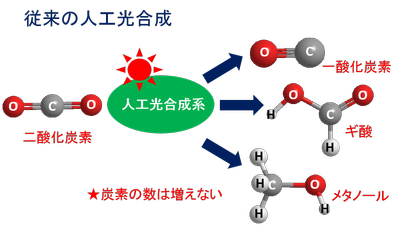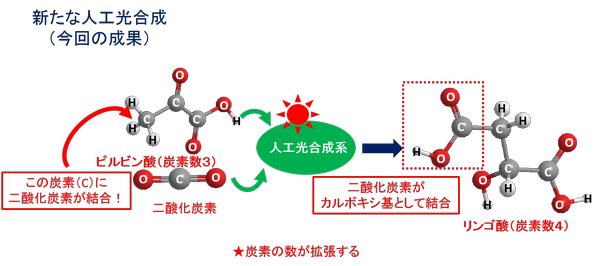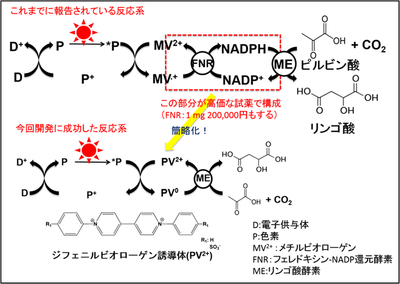Research Results
Sep 3, 2018
- Press Release
- Research Paper
A press release announcing the research findings of Prof. Yutaka Amao's group has been issued
Researchers have successfully developed a novel artificial photosynthesis system capable of capturing carbon dioxide by incorporating it into organic molecules.
A group led by Professor Yutaka Amao (Research Center for Artificial Photosynthesis, Osaka City University) and Takeyuki Katagiri, a second-year doctoral student in the Department of Materials and Molecular Science at the Graduate School of Science, have successfully developed a new artificial photosynthesis technology capable of fixing carbon dioxide by binding it to organic molecules using visible light energy. This research result was published in Pure and Applied Chemistry, a journal of the International Union of Pure and Applied Chemistry (IUPAC), on September 3, 2018.
Research Summary
Most conventional artificial photosynthesis systems have been designed to photoreduce carbon dioxide into simple molecules such as carbon monoxide, formic acid, formaldehyde, and methanol. These systems, which reduce carbon dioxide with a single carbon atom, are limited to producing compounds with only one carbon atom (Fig. 1). In contrast, natural photosynthesis employs the reducing power generated by sunlight to reduce carbon dioxide, extend the carbon chain, and eventually synthesize glucose, a molecule with six carbon atoms. By mimicking this natural process and extending the carbon chain, we could potentially develop new methods for synthesizing a wide range of materials from carbon dioxide.

Fig1: Overview of conventional artificial photosynthesis
Inspired by the carbon fixation reaction in natural photosynthesis, we have developed a novel system that can incorporate carbon dioxide into an organic molecule (pyruvate) as a carboxyl group, producing malic acid. This system utilizes visible light energy to generate reducing power through the cooperation of dye molecules, electron transfer molecules, and biocatalysts. (Fig. 2)

Fig2: New Artificial Photosynthesis (Results of this study)
Our newly developed system combines malic enzyme, which catalyzes the carboxylation of pyruvate (a three-carbon compound) to form malate (a four-carbon compound), with a novel photoreduction system utilizing a "diphenylviologen derivative".
Previous attempts to produce malic acid using malic enzyme as a catalyst and visible light have relied on complex systems that require a variety of expensive reagents. As shown in Figure 3, the specific reaction component enclosed by the dotted line has been a particular bottleneck, hindering research progress due to its high cost and low efficiency. Specifically, in a reaction system linking a water-soluble porphyrin as a dye, a diphenylviologen derivative, and malic enzyme, approximately 5% of the starting materials, pyruvate and carbon dioxide, were converted to malic acid by visible light irradiation for 3 hours.

Figure 3
While previous artificial photosynthesis systems have centered around carbon dioxide reduction, our newly developed system offers a novel approach that utilizes carbon dioxide as a starting material.
Future Developments
The results of this study demonstrate a system that can be expanded to utilize biocatalysts driven by solar energy for the conversion of carbon dioxide into resources and the synthesis of various organic molecules. In recent years, research on the combination of biocatalysts with semiconductor photocatalysts and organic-inorganic materials has been progressing. Enzymes that catalyze carbon dioxide fixation reactions have the advantage of high product selectivity. We aim to develop novel artificial photosynthesis systems that not only convert carbon dioxide into fuels but also expand their applications to the synthesis of various chemicals and useful substances by incorporating carbon dioxide into organic molecules.
Addendum
This research was awarded the RSC Green Chemistry Poster Prize at the 7th International IUPAC Conference on Green Chemistry held in Moscow, Russia, in October 2017.
IUPAC, established in 1919, is recognized globally as an authority on the standardization of naming elements and compounds (IUPAC nomenclature).
(RSC:Royal Society of Chemistry)
Publication Information
| Publications: | Pure and Applied Chemistry (International Union of Pure and Applied Chemistry IUPAC) |
|---|---|
| Title of Paper: | Visible Light-induced Reduction System of Diphenylviologen Derivative with Water-soluble Porphyrin for Biocatalytic Carbon-carbon Bond Formation from CO2 |
| Author: | Takayuki Katagiri, Kohei Fujita, Shusaku Ikeyama, Yutaka Amao |
| URL: | https://doi.org/10.1515/pac-2018-0402 |
Article source: Osaka City University website